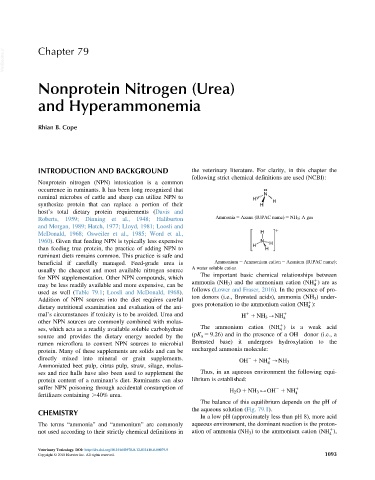Page 1161 - Veterinary Toxicology, Basic and Clinical Principles, 3rd Edition
P. 1161
VetBooks.ir Chapter 79
Nonprotein Nitrogen (Urea)
and Hyperammonemia
Rhian B. Cope
INTRODUCTION AND BACKGROUND the veterinary literature. For clarity, in this chapter the
following strict chemical definitions are used (NCBI):
Nonprotein nitrogen (NPN) intoxication is a common
occurrence in ruminants. It has been long recognized that
ruminal microbes of cattle and sheep can utilize NPN to
synthesize protein that can replace a portion of their
host’s total dietary protein requirements (Davis and
Roberts, 1959; Dinning et al., 1948; Haliburton Ammonia 5 Azane (IUPAC name) 5 NH 3 ; A gas
and Morgan, 1989; Hatch, 1977; Lloyd, 1981; Loosli and
McDonald, 1968; Osweiler et al., 1985; Word et al.,
1960). Given that feeding NPN is typically less expensive
than feeding true protein, the practice of adding NPN to
ruminant diets remains common. This practice is safe and
beneficial if carefully managed. Feed-grade urea is Ammonium 5 Ammonium cation 5 Azanium (IUPAC name);
usually the cheapest and most available nitrogen source A water soluble cation
The important basic chemical relationships between
for NPN supplementation. Other NPN compounds, which 1
ammonia (NH 3 ) and the ammonium cation (NH ) are as
may be less readily available and more expensive, can be 4
follows (Lower and Fraser, 2016). In the presence of pro-
used as well (Table 79.1; Loosli and McDonald, 1968).
ton donors (i.e., Brønsted acids), ammonia (NH 3 ) under-
Addition of NPN sources into the diet requires careful 1
goes protonation to the ammonium cation (NH ):
dietary nutritional examination and evaluation of the ani- 4
1
mal’s circumstances if toxicity is to be avoided. Urea and H 1 NH 3 -NH 1
4
other NPN sources are commonly combined with molas- 1
ses, which acts as a readily available soluble carbohydrate The ammonium cation (NH ) is a weak acid
4
2
source and provides the dietary energy needed by the (pK a 5 9.26) and in the presence of a OH donor (i.e., a
rumen microflora to convert NPN sources to microbial Brønsted base) it undergoes hydroxylation to the
protein. Many of these supplements are solids and can be uncharged ammonia molecule:
directly mixed into mineral or grain supplements. 2 1
OH 1 NH -NH 3
4
Ammoniated beet pulp, citrus pulp, straw, silage, molas-
ses and rice hulls have also been used to supplement the Thus, in an aqueous environment the following equi-
protein content of a ruminant’s diet. Ruminants can also librium is established:
suffer NPN poisoning through accidental consumption of 2 1
H 2 O 1 NH 3 2OH 1 NH 4
fertilizers containing .40% urea.
The balance of this equilibrium depends on the pH of
the aqueous solution (Fig. 79.1).
CHEMISTRY
In a low pH (approximately less than pH 8), more acid
The terms “ammonia” and “ammonium” are commonly aqueous environment, the dominant reaction is the proton-
1
not used according to their strictly chemical definitions in ation of ammonia (NH 3 ) to the ammonium cation (NH ),
4
Veterinary Toxicology. DOI: http://dx.doi.org/10.1016/B978-0-12-811410-0.00079-9
Copyright © 2018 Elsevier Inc. All rights reserved. 1093

